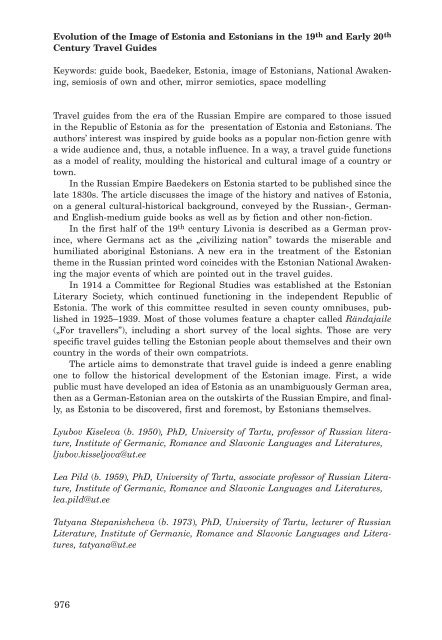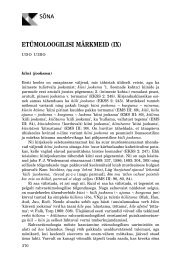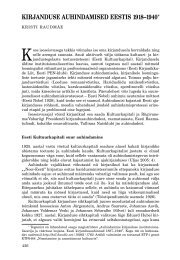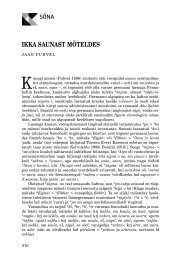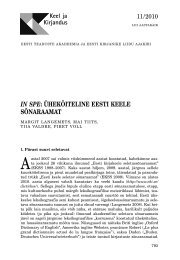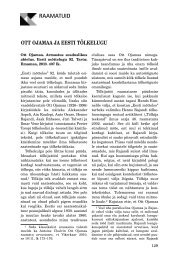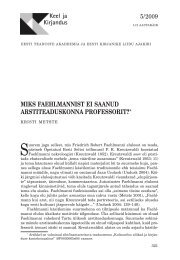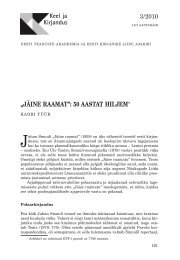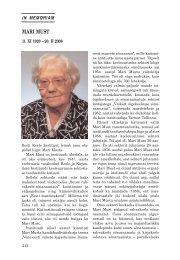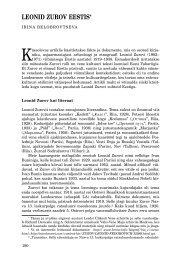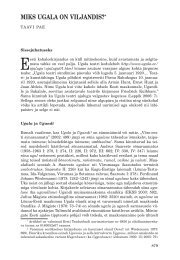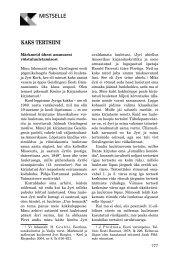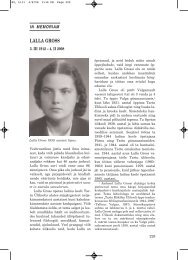eestimaa ja eestlaste kuvandi areng xix sajandi ... - Keel ja Kirjandus
eestimaa ja eestlaste kuvandi areng xix sajandi ... - Keel ja Kirjandus
eestimaa ja eestlaste kuvandi areng xix sajandi ... - Keel ja Kirjandus
Create successful ePaper yourself
Turn your PDF publications into a flip-book with our unique Google optimized e-Paper software.
Kisseljova 12/2/08 5:34 PM Page 976Evolution of the Image of Estonia and Estonians in the 19 th and Early 20 thCentury Travel GuidesKeywords: guide book, Baedeker, Estonia, image of Estonians, National Awakening,semiosis of own and other, mirror semiotics, space modellingTravel guides from the era of the Russian Empire are compared to those issuedin the Republic of Estonia as for the presentation of Estonia and Estonians. Theauthors’ interest was inspired by guide books as a popular non-fiction genre witha wide audience and, thus, a notable influence. In a way, a travel guide functionsas a model of reality, moulding the historical and cultural image of a country ortown.In the Russian Empire Baedekers on Estonia started to be published since thelate 1830s. The article discusses the image of the history and natives of Estonia,on a general cultural-historical background, conveyed by the Russian-, GermanandEnglish-medium guide books as well as by fiction and other non-fiction.In the first half of the 19 th century Livonia is described as a German province,where Germans act as the „civilizing nation” towards the miserable andhumiliated aboriginal Estonians. A new era in the treatment of the Estoniantheme in the Russian printed word coincides with the Estonian National Awakeningthe major events of which are pointed out in the travel guides.In 1914 a Committee for Regional Studies was established at the EstonianLiterary Society, which continued functioning in the independent Republic ofEstonia. The work of this committee resulted in seven county omnibuses, publishedin 1925–1939. Most of those volumes feature a chapter called Rända<strong>ja</strong>ile(„For travellers”), including a short survey of the local sights. Those are veryspecific travel guides telling the Estonian people about themselves and their owncountry in the words of their own compatriots.The article aims to demonstrate that travel guide is indeed a genre enablingone to follow the historical development of the Estonian image. First, a widepublic must have developed an idea of Estonia as an unambiguously German area,then as a German-Estonian area on the outskirts of the Russian Empire, and finally,as Estonia to be discovered, first and foremost, by Estonians themselves.Lyubov Kiseleva (b. 1950), PhD, University of Tartu, professor of Russian literature,Institute of Germanic, Romance and Slavonic Languages and Literatures,ljubov.kisseljova@ut.eeLea Pild (b. 1959), PhD, University of Tartu, associate professor of Russian Literature,Institute of Germanic, Romance and Slavonic Languages and Literatures,lea.pild@ut.eeTatyana Stepanishcheva (b. 1973), PhD, University of Tartu, lecturer of RussianLiterature, Institute of Germanic, Romance and Slavonic Languages and Literatures,tatyana@ut.ee976


